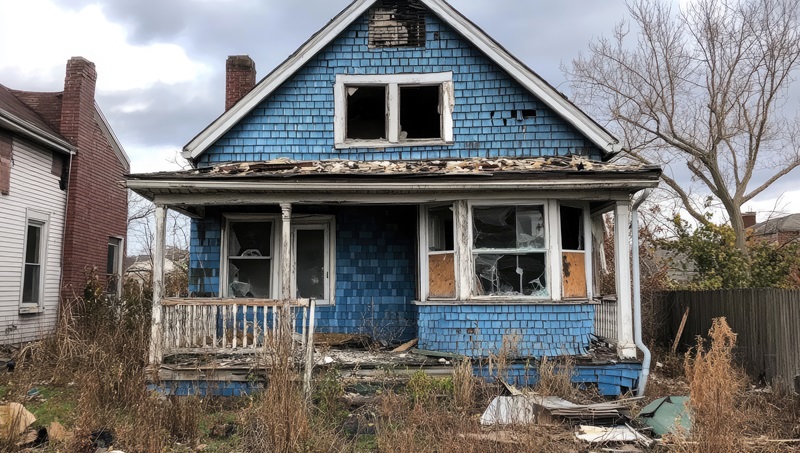ATTOM has released its Q3 2025 Vacant Property and Zombie Foreclosure Report, showing that 1.4 million (1,385,902) residential properties (1.3% of all homes in the U.S.) are vacant. The national vacancy rate has been consistent for nearly three-and-a-half years now as the nation has experienced a high-demand housing market.
In analyzing the data, ATTOM found that 222,318 properties across the country were in the process of foreclosure in Q3. Of those pre-foreclosure homes, approximately 3.38% or 7,519 were “zombie” properties, meaning they had been abandoned by their owner. That was slightly higher than what was found in Q2, when just 3.30% of pre-foreclosure homes were considered zombies, and more than the 3.14% zombie rate posted in Q3 of 2024.
“Vacant and zombie homes can hurt the value of surrounding properties and start a negative spiral in a local housing market,” said Rob Barber, CEO of ATTOM. “While we’ve seen the rate of zombie homes tick up a tiny bit this quarter, the overall rate of vacant homes and homes in the foreclosure process has remained remarkably steady.”
For the report, ATTOM analyzed county tax assessor data for 104.2 million residential properties for vacancy, broken down by foreclosure status and owner-occupancy status in Q3 of 2025. Only metropolitan statistical areas (MSAs) with at least 100,000 residential properties, counties with at least 50,000 residential properties and zip codes with at least 1,000 residential properties were included in the analysis.
Quarter-over-quarter, the number of zombie properties rose in 23 states, but mostly by single-digit or small double-digit amounts. Likewise, in the 23 states and the District of Columbia where there were fewer zombie properties in Q3 than Q2, the changes were relatively small. Four states reported no change in the number of zombie properties.
Among states with at least 50 zombie properties, those reporting the largest year-over-year increase in the rate of pre-foreclosure homes that were considered zombies were found in:
- Colorado (up 115% from 27 to 58)
- Washington (up 114% from 29 to 62)
- Iowa (up 84% from 64 to 118)
- North Carolina (up 80% from 50 to 90)
- Oklahoma (up 72% from 43 to 74)
“While there remain some markets with worryingly high rates of vacancies, as a whole it appears that the nation’s buyers are quickly filling homes that become available,” added Barber.
The biggest year-over-year decreases in zombie rates among states with at least 50 zombie properties were found in:
- Georgia (down 25% from 85 to 64)
- New Jersey (down 21% from 230 to 181)
- Illinois (down 17% from 780 to 646)
- New York (down 10% from 1,630 to 1,461)
Lowest Vacancy Rates Found in the Northeast
The states reporting the highest vacant property rate in Q3 of 2025 were:
- Oklahoma (2.4%)
- Kansas (2.3%)
- Alabama (2.2%)
- Missouri (2.2%)
- West Virginia (2.1%)
The states reporting the lowest vacancy rates were:
- New Hampshire (0.35%)
- Vermont (0.41%)
- New Jersey (0.51%)
- Idaho (0.51%)
- Connecticut (0.54%)
Where Can High Instances of Zombie Rates be Found?
Of the 135 large metro areas in the analysis with at least 100,000 residential properties and 100 properties in the foreclosure process in Q3, 57% (77) had zombie foreclosure rates below the national average of 3.38%.
The large metro areas with the largest proportions of vacant pre-foreclosure homes or ‘zombie’ homes were found predominantly in the Midwest region:
- Wichita, Kansas (12.7% of properties in the foreclosure process are vacant)
- Peoria, Illinois (12.3%)
- Youngstown, Ohio (10.1%)
- Cleveland, Ohio (9.5%)
- Toledo, Ohio (8.8 percent)
The metros reporting the smallest proportion of zombie foreclosures were found in:
- Nashville, Tennessee (0% of properties in the foreclosure process were vacant)
- Atlantic City, New Jersey (0.3%)
- Provo, Utah (0.4%)
- Trenton, New Jersey (0.6%)
- Raleigh, North Carolina (0.7%)
Investor-Owned Properties More Likely to be Zombies
In Q3, there were about 24.9 million investor-owned properties, of which 3.6% (882,336) were vacant. Affordability issues and inflation may have driven this number upward, as higher rates and may have caused many to struggle paying one mortgage let alone several.
The states reporting the highest vacancy rates in investor-owned properties were:
- Indiana (7.2%)
- Illinois (6.1%)
- Oklahoma (5.9%)
- Alabama (5.9%)
- Ohio (5.8%)
The states reporting the lowest vacancy rates in investor-owned properties were:
- New Hampshire (0.9%)
- Vermont (1%)
- Idaho (1.2%)
- Utah (1.5%)
- North Dakota (1.5%)
Nearly two thirds of the zip codes (1,376 out of 2,164) with at least 1,000 residential properties and 25 pre-foreclosure properties in Q3 of 2025 had zombie foreclosure rates below the national average of 3.38%. The zip codes reporting the highest zombie foreclosure rates were:
- 91001 in Los Angeles, California (80.8%)
- 61603 in Peoria, Illinois (40%)
- 46201 in Indianapolis, Indiana (35.5%)
- 33708 in Tampa, Florida (34.9%)
- 44108 in Cleveland, Ohio (32.2%)
Click here for more on ATTOM’s Q3 2025 Vacant Property and Zombie Foreclosure Report.






